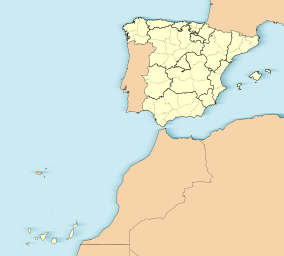| This article needs additional citations for verification. Please help improve this article by adding citations to reliable sources. Unsourced material may be challenged and removed. Find sources: "Timanfaya National Park" – news · newspapers · books · scholar · JSTOR (April 2014) (Learn how and when to remove this message) |
| Timanfaya National Park | |
|---|---|
| Parque Nacional de Timanfaya | |
| IUCN category II (national park) | |
 | |
  | |
| Location | Lanzarote, Canary Islands, Spain |
| Coordinates | 28°59′39″N 13°47′36″W / 28.99417°N 13.79333°W / 28.99417; -13.79333 |
| Area | 51.07 km (19.72 sq mi) |
| Established | 1974 |
Timanfaya National Park (Spanish: Parque Nacional de Timanfaya) is a Spanish national park in the southwestern part of the island of Lanzarote, in the Canary Islands. It covers parts of the municipalities Tinajo and Yaiza. The area is 51.07 square kilometres (19.72 sq mi), and the parkland is entirely made up of volcanic soil. The statue El Diablo by César Manrique is its symbol. It is the only National Park in Spain which is entirely geological. Timanfaya National Park represents a sign of recent and historical volcanism in the Macaronesian Region. The last volcanic eruptions occurred during the 18th century as well as in the 19th century.
Volcanic activity
See also: Geology of the Canary IslandsThe greatest recorded eruptions occurred between 1730 and 1736. The volcanic activity continues as the surface temperature in the core ranges from 100 to 600 °C (212 to 1,112 °F) at the depth of 13 metres (43 ft), which is demonstrated by pouring water into the ground, resulting in a geyser of steam which is an attraction for tourists. There is only one active volcano, Timanfaya volcano, after which the park is named.
Ecological value

In 1993, UNESCO designated a Biosphere reserve covering the whole of Lanzarote. The national park is one of the core areas of the biosphere reserve.
Access to the park by the public is strictly regulated to protect the delicate flora and fauna. There are one or two footpaths, and a popular short route where one can visit by camel. There is a public car park from which one can tour the volcanic landscape by coach using a road that is otherwise closed to the public.

References
- "Protected Natural Areas". Gobierno de Canarias. Archived from the original on 24 September 2015.
- "Timanfaya". Gobierno de Canarias. Retrieved 14 January 2021.
- "The Geology of the Canary Islands - 1st Edition". www.elsevier.com. Retrieved 2020-10-13.
External links
 Media related to Parque Nacional de Timanfaya at Wikimedia Commons
Media related to Parque Nacional de Timanfaya at Wikimedia Commons- https://www.miteco.gob.es/en/parques-nacionales-oapn/red-parques-nacionales/parques-nacionales/timanfaya.html
- More Information and how to get there
| National Parks of Spain | |
|---|---|
| Administrator: National Parks Autonomous Agency | |
| National parks | |
This Canary Islands location article is a stub. You can help Misplaced Pages by expanding it. |





